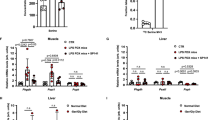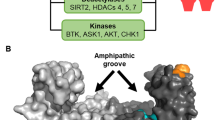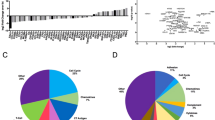Abstract
Dedifferentiated liposarcoma (DDLPS) accounts for 15–20% of liposarcoma (LPS) and has high rates of local recurrence and distant metastasis. Hyperactivation of yes-associated protein (YAP) has been implicated in DDLPS development. However, the mechanisms that drive aberrant YAP signaling remain largely unknown. Here, we show that tumor protein p53 inducible nuclear protein 2 (TP53INP2) is a potential negative modulator of the malignant progression of DDLPS. The TP53INP2 protein expression level in tumor tissues from 79 patients with DDLPS decreased progressively. Compared with primary tumors, recurrent tumors also exhibited reduced TP53INP2 expression. More importantly, low TP53INP2 expression is correlated with poor prognosis. TP53INP2 gain- or loss-of-function experiments in DDLPS cell lines showed profound inhibitory effects on processes and properties linked with cancer malignancy, such as proliferation, migration, stemness and dedifferentiation. Mechanistically, TP53INP2 is located mainly in mitochondria and promotes mitophagic degradation of YAP in a VDAC1-dependent manner. The WW ___domain in YAP and the PPTY motif in VDAC1 are required for their interaction. Taken together, these data demonstrate that TP53INP2 represses the malignant progression of DDLPS by inactivating YAP via a mitophagy-dependent mechanism and that TP53INP2 may constitute a novel prognostic biomarker for advanced DDLPS.

This is a preview of subscription content, access via your institution
Access options
Subscribe to this journal
Receive 50 print issues and online access
269,00 € per year
only 5,38 € per issue
Buy this article
- Purchase on SpringerLink
- Instant access to full article PDF
Prices may be subject to local taxes which are calculated during checkout






Similar content being viewed by others
Data availability
The RNA-seq data discussed in this publication has been deposited into the Gene Expression Omnibus (GSE263328). All study data are included in this article and Supplementary Materials.
References
Crago AM, Dickson MA. Liposarcoma: Multimodality Management and Future Targeted Therapies. Surg Oncol Clin N. Am. 2016;25:761–73.
WHO. The WHO Classification of Tumours Soft Tissue and Bone Tumours, 5th edn. Lyon: IARC Press, 2020.
Thway K. Well-differentiated liposarcoma and dedifferentiated liposarcoma: An updated review. Semin Diagn Pathol. 2019;36:112–21.
Thway K, Jones RL, Noujaim J, Zaidi S, Miah AB, Fisher C. Dedifferentiated Liposarcoma: Updates on Morphology, Genetics, and Therapeutic Strategies. Adv Anat Pathol. 2016;23:30–40.
Crago AM, Singer S. Clinical and molecular approaches to well differentiated and dedifferentiated liposarcoma. Curr Opin Oncol. 2011;23:373–8.
Italiano A, Bianchini L, Keslair F, Bonnafous S, Cardot-Leccia N, Coindre JM, et al. HMGA2 is the partner of MDM2 in well-differentiated and dedifferentiated liposarcomas whereas CDK4 belongs to a distinct inconsistent amplicon. Int J Cancer. 2008;122:2233–41.
Fullenkamp CA, Hall SL, Jaber OI, Pakalniskis BL, Savage EC, Savage JM, et al. TAZ and YAP are frequently activated oncoproteins in sarcomas. Oncotarget. 2016;7:30094–108.
Shrestha M, Ando T, Chea C, Sakamoto S, Nishisaka T, Ogawa I, et al. The transition of tissue inhibitor of metalloproteinases from -4 to -1 induces aggressive behavior and poor patient survival in dedifferentiated liposarcoma via YAP/TAZ activation. Carcinogenesis. 2019;40:1288–97.
Morciano G, Vezzani B, Missiroli S, Boncompagni C, Pinton P, Giorgi C. An Updated Understanding of the Role of YAP in Driving Oncogenic Responses. Cancers (Basel). 2021;13:3100.
Isfort I, Elges S, Cyra M, Berthold R, Renner M, Mechtersheimer G, et al. Prevalence of the Hippo Effectors YAP1/TAZ in Tumors of Soft Tissue and Bone. Sci Rep. 2019;9:19704.
Pan D. The hippo signaling pathway in development and cancer. Dev Cell. 2010;19:491–505.
Xu Y, Wan W. The bifunctional role of TP53INP2 in transcription and autophagy. Autophagy. 2020;16:1341–43.
Xu Y, Wan W, Shou X, Huang R, You Z, Shou Y, et al. TP53INP2/DOR, a mediator of cell autophagy, promotes rDNA transcription via facilitating the assembly of the POLR1/RNA polymerase I preinitiation complex at rDNA promoters. Autophagy. 2016;12:1118–28.
Mauvezin C, Orpinell M, Francis VA, Mansilla F, Duran J, Ribas V, et al. The nuclear cofactor DOR regulates autophagy in mammalian and Drosophila cells. EMBO Rep. 2010;11:37–44.
Nowak J, Archange C, Tardivel-Lacombe J, Pontarotti P, Pebusque MJ, Vaccaro MI, et al. The TP53INP2 protein is required for autophagy in mammalian cells. Mol Biol Cell. 2009;20:870–81.
Romero M, Sabate-Perez A, Francis VA, Castrillon-Rodriguez I, Diaz-Ramos A, Sanchez-Feutrie M, et al. TP53INP2 regulates adiposity by activating beta-catenin through autophagy-dependent sequestration of GSK3beta. Nat Cell Biol. 2018;20:443–54.
Sabate-Perez A, Romero M, Sanchez-Fernandez-de-Landa P, Carobbio S, Mouratidis M, Sala D, et al. Autophagy-mediated NCOR1 degradation is required for brown fat maturation and thermogenesis. Autophagy. 2023;19:904–25.
Wang L, Wang L, Gu Y, Shu Y, Shen Y, Xu Q. Integrin alpha6(high) cell population functions as an initiator in tumorigenesis and relapse of human liposarcoma. Mol Cancer Ther. 2011;10:2276–86.
Xue W, Li X, Li W, Wang Y, Jiang C, Zhou L, et al. Intracellular CYTL1, a novel tumor suppressor, stabilizes NDUFV1 to inhibit metabolic reprogramming in breast cancer. Signal Transduct Target Ther. 2022;7:35.
Gao J, Fan M, Xiang G, Wang J, Zhang X, Guo W, et al. Diptoindonesin G promotes ERK-mediated nuclear translocation of p-STAT1 (Ser727) and cell differentiation in AML cells. Cell Death Dis. 2017;8:e2765.
Fan M, Chen J, Gao J, Xue W, Wang Y, Li W, et al. Triggering a switch from basal- to luminal-like breast cancer subtype by the small-molecule diptoindonesin G via induction of GABARAPL1. Cell Death Dis. 2020;11:635.
Singer S, Antonescu CR, Riedel E, Brennan MF. Histologic subtype and margin of resection predict pattern of recurrence and survival for retroperitoneal liposarcoma. Ann Surg. 2003;238:358–70.
Hu Y, Li X, Xue W, Pang J, Meng Y, Shen Y, et al. TP53INP2-related basal autophagy is involved in the growth and malignant progression in human liposarcoma cells. Biomed Pharmacother. 2017;88:562–68.
Wang L, Li W, Yang Y, Hu Y, Gu Y, Shu Y, et al. High expression of sarcoplasmic/endoplasmic reticulum Ca(2+)-ATPase 2b blocks cell differentiation in human liposarcoma cells. Life Sci. 2014;99:37–43.
Chang JY, Yi HS, Kim HW, Shong M. Dysregulation of mitophagy in carcinogenesis and tumor progression. Biochim Biophys Acta Bioenerg. 2017;1858:633–40.
Katayama H, Kogure T, Mizushima N, Yoshimori T, Miyawaki A. A sensitive and quantitative technique for detecting autophagic events based on lysosomal delivery. Chem Biol. 2011;18:1042–52.
Reggiani F, Gobbi G, Ciarrocchi A, Sancisi V. YAP and TAZ Are Not Identical Twins. Trends Biochem Sci. 2021;46:154–68.
Zhao B, Li L, Lu Q, Wang LH, Liu CY, Lei Q, et al. Angiomotin is a novel Hippo pathway component that inhibits YAP oncoprotein. Genes Dev. 2011;25:51–63.
Yang Y, Luo M, Zhang K, Zhang J, Gao T, Connell DO, et al. Nedd4 ubiquitylates VDAC2/3 to suppress erastin-induced ferroptosis in melanoma. Nat Commun. 2020;11:433.
Geisler S, Holmstrom KM, Skujat D, Fiesel FC, Rothfuss OC, Kahle PJ, et al. PINK1/Parkin-mediated mitophagy is dependent on VDAC1 and p62/SQSTM1. Nat Cell Biol. 2010;12:119–31.
Ham SJ, Lee D, Yoo H, Jun K, Shin H, Chung J. Decision between mitophagy and apoptosis by Parkin via VDAC1 ubiquitination. Proc Natl Acad Sci USA. 2020;117:4281–91.
Nguyen TN, Padman BS, Lazarou M. Deciphering the Molecular Signals of PINK1/Parkin Mitophagy. Trends Cell Biol. 2016;26:733–44.
Xu Y, Wan W. TP53INP2 mediates autophagic degradation of ubiquitinated proteins through its ubiquitin-interacting motif. FEBS Lett. 2019;593:1974–82.
Penna F, Ballaro R, Martinez-Cristobal P, Sala D, Sebastian D, Busquets S, et al. Autophagy Exacerbates Muscle Wasting in Cancer Cachexia and Impairs Mitochondrial Function. J Mol Biol. 2019;431:2674–86.
Xun J, Song X, Gao S, Yang H, Li Z, Li L. Identification of sequence polymorphisms in the D-loop region of mitochondrial DNA as risk biomarker for liposarcoma. Mitochondrial DNA A DNA Mapp Seq Anal. 2016;27:3403–4.
Rocca C, Soda T, De Francesco EM, Fiorillo M, Moccia F, Viglietto G, et al. Mitochondrial dysfunction at the crossroad of cardiovascular diseases and cancer. J Transl Med. 2023;21:635.
Eisinger-Mathason TS, Mucaj V, Biju KM, Nakazawa MS, Gohil M, Cash TP, et al. Deregulation of the Hippo pathway in soft-tissue sarcoma promotes FOXM1 expression and tumorigenesis. Proc Natl Acad Sci USA. 2015;112:E3402–11.
Carmagnani Pestana R, Moyers JT, Roszik J, Sen S, Hong DS, Naing A, et al. Impact of Biomarker-Matched Therapies on Outcomes in Patients with Sarcoma Enrolled in Early-Phase Clinical Trials (SAMBA 101). Clin Cancer Res. 2023;29:1708–18.
Acknowledgements
We thank Dianhua Chen (School of Life Sciences, Nanjing University) for technological assistance.
Funding
This work was supported by National Natural Science Foundation of China (Grant Nos. 81974504, 82230116), National Key R&D Program of China (Grant No. 2022YFC3500202), and Innovation Team and Talents Cultivation Program of National Administration of Traditional Chinese Medicine (Grant No. ZYYCXTD-C-202208).
Author information
Authors and Affiliations
Contributions
YS and QX designed this study. XF and RC collected the clinical samples. YXW, YH, LWW, ZXC, LZ and GYL performed experiments and analysis data. JWY and RC contributed to the discussion. YXW. and YS wrote the manuscript.
Corresponding authors
Ethics declarations
Competing interests
The authors declare no competing interests.
Ethics approval and consent to participate
All experiments related to clinical specimens were conducted in accordance with the ethical standards of the Declaration of Helsinki and according to national and international guidelines and were approved by the Research Ethics Committee of Shanghai Changhai Hospital (Approval number: CHEC2019-142). Informed consent was obtained from all participants.
Additional information
Publisher’s note Springer Nature remains neutral with regard to jurisdictional claims in published maps and institutional affiliations.
Supplementary information
Rights and permissions
Springer Nature or its licensor (e.g. a society or other partner) holds exclusive rights to this article under a publishing agreement with the author(s) or other rightsholder(s); author self-archiving of the accepted manuscript version of this article is solely governed by the terms of such publishing agreement and applicable law.
About this article
Cite this article
Wang, Y., Huang, Y., Wang, L. et al. TP53INP2 promotes mitophagic degradation of YAP to impede dedifferentiated liposarcoma development. Oncogene 44, 2054–2063 (2025). https://doi.org/10.1038/s41388-025-03358-4
Received:
Revised:
Accepted:
Published:
Issue Date:
DOI: https://doi.org/10.1038/s41388-025-03358-4



